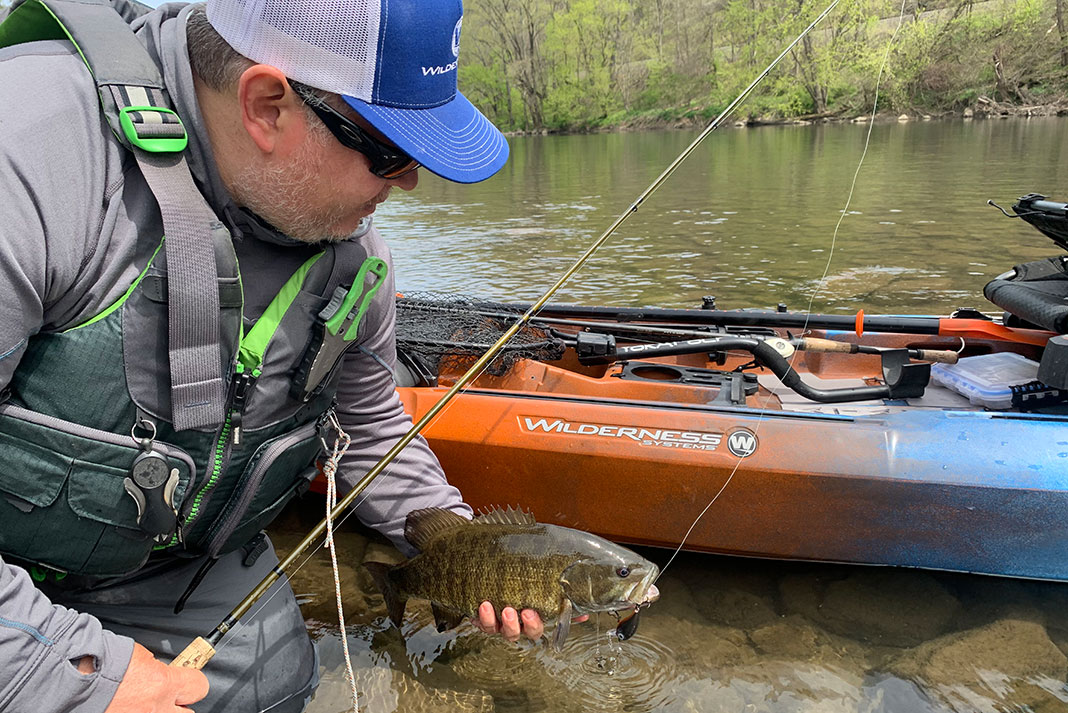
Forget about choosing between a tight wobbling crankbait or a wide wobble crankbait. Don’t fret about bill shape and the number of rattles. Instead, focus on location, depth, speed and color, the four most important variables in crankbait fishing for river bass.
River Crankbait Tactics for Trophy Smallmouth
Location
A crankbait is a hard-plastic lure with a clear plastic bill or slanted head. Retrieve the lure and the design causes it to dig into the water and dive at an angle. The size and shape of the bill determines how deep the lure dives.
Crankbait fishing heats up when the bass stage in feeding stations adjacent to prime spawning territories. Prospect deep, slow current breaks within sight of shallow, gravel-laden spawning areas. Bridge pilings, ledge rock, car sized boulders and log jams create current breaks river bass use as feeding stations prior to going shallow to spawn.
Depth
Crankbaits trigger strikes when the lure is grinding bottom and deflecting off rocks and deadfalls. Each crankbait is labeled with the depth range it swims. Choose a crankbait covering the depth of the river. For example, my local rivers are shallow, so I have one rod rigged with a one- to three-foot deep crankbait and another rod holding a deeper five- to seven-foot deep crankbait.
Speed
Slow is the way to go for early-season crankbaiting. To make sure my crankbait swims at depth with a slow steady retrieve, I use a crankbait with a larger bill. To really slow my retrieve, I will use a crankbait rated deeper than the water I’m fishing. Even with a slow retrieve, I want to feel every bump and grind of the crankbait slowly crawling across the bottom.
Color
I keep color choices simple. I don’t labor over exactly matching the color and pattern of local forage. In clear water, I use natural colors and patterns. When the water is dirty, I go with darker lures with a black back. Even a dark crankbait should have a bright orange, yellow or white belly. As the crankbait swims, the bright belly flashes and wobbles to trigger the fish to bite.
Rod, Reel and Line
A seven-foot, four-inch, fast-action, medium-heavy power Temple Forks Outfitter baitcast rod is perfect for crankbait fishing. The fast-action tip launches an accurate cast while the medium-heavy power provides a softer bend to allow the crankbait to swim freely.
I match the rod to a Shimano Curado baitcasting reel with a fast 7.4:1 retrieve ratio. The reel allows me to quickly retrieve the lure between casts saving time and energy. With the high-speed reel, I can still slow down the retrieve to keep the lure bouncing along the bottom.
I spool the reel with 10-pound-test monofilament line. Monofilament stretches more than fluorocarbon or braid. The line’s forgiveness allows the bass to turn and swim away with the lure before feeling pressure. This gives me a split second advantage in reaction time.
Positioning
In crankbait fishing, boat position is an extension of presentation. In order for the crankbait to work correctly, the kayak has to be positioned perfectly.
To start, I try to keep my kayak stationary so I can make a precise cast and cover the target area.
To stop the kayak, I eddie out behind an adjacent structure or pull the kayak on a shallow rock or bar. If the area is really fishy, I drop a bow anchor. The key is to position the kayak with the bow pointing upstream towards the target structure.
Presentation
Two basic presentation strategies produce my heaviest bass. The first and most effective is casting upstream past the target and retrieving the crankbait directly downstream through the area. Presenting the crankbait moving fast and straight downstream forces the bass to make a reaction bite.
If the current is too strong or I can’t get into perfect position for the upstream approach, the second choice is casting at an angle upstream and retrieving through the target area at a 45-degree angle. This presentation shows the bass the crankbait’s side profile and gives the fish an easy target.
Once I make the perfect cast, I retrieve fast enough to feel the resistance of the crankbait bill digging into the water. After a few turns of the reel handle, the lure should be grinding bottom.
Once the lure hits bottom, I like a slow, steady retrieve with my rod tip close to the water and pointing at the crankbait. To entice early season bass to bite, I pause the retrieve for two or three seconds to let the lure float up a few inches from the bottom.
Detecting Strikes
The biggest challenge is feeling the fish bite. Smallmouth can be lethargic and looking for an easy meal. Many times, the fish will follow the crankbait, engulf it and move to the side. When I see my line move to the side or I feel the crankbait’s vibration change, I set the hook.
Cranking Strategies
Crankbait fishing for river smallmouth is effective and a lot of fun. Crankbaits are most effective when bass are spread out requiring the angler to cover water in search of a bite. Crankbaits swim faster than a jig or tube, so I make more casts and increase the odds of encountering a feeding fish.
It’s the experience of crankbait fishing that has me smitten. Firing a cast into a feeding station, feeling the vibrating lure grind and stutter across the bottom, watching for the slightest change in cadence or movement of the line, then setting the hook against the heavy pull of a big smallmouth makes crankbait fishing one of my favorite tactics.
Fishing hardbaits requires dedication and practice, but the payoff is worth the work. | Feature photo: Juan Veruete